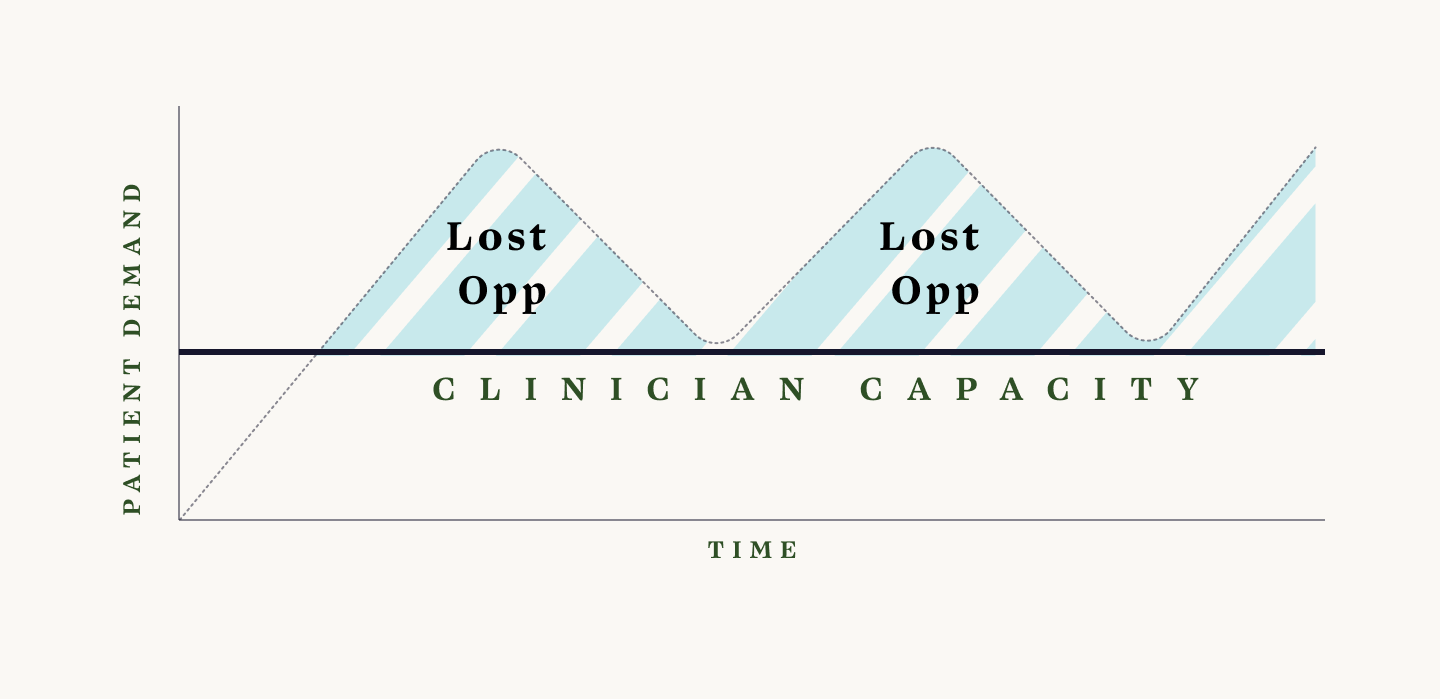Unpacking the Economics of Virtual Care Supply & Demand

The variability of patient demand poses immense economic challenges for virtual care companies. Learn how to build a fiscally advantageous telehealth business model on a national scale.
The key to running a successful virtual care business lies in understanding the right level of clinician supply needed to meet patient demand. Without insight into how to manage precision staffing, a virtual care business can run into financial problems rather quickly, limiting growth.
To illustrate this concept, we first need to unpack the limitations that impact clinician staffing. Then, we’ll explore the economics of lost revenue and missed opportunities in virtual care. Finally, we’ll discuss potential solutions for setting up a fiscally advantageous business model by leveraging the concept of load balancing and turning fixed costs into variable expenses.
Challenges of precision staffing for telehealth
The importance of fully preparing for the complexities of clinical staffing inherent in digital care models can’t be underestimated. In order to meet consumer needs for near-instant care without undue economic burden, innovators must grapple with the intricacies associated with precision staff modeling.
This concept is critical for any company looking to deploy a nationwide virtual care service or a service covering multiple state geographies.
How state licensing regulations impact clinical staffing for telehealth
State-by-state telehealth regulations add an additional layer of complexity to delivering nationwide patient care, as each clinician must be licensed in the state in which the patient resides (generally speaking, though there are exceptions).
This means if a patient in Georgia is requesting care, you must have a clinician with a Georgia license available to deliver that care. This makes it difficult to align clinical resources with patient demand at a macro level.
On any given day, you could be overstaffed in California but understaffed in New York, and due to the regulatory puzzle of state licensing, you can’t easily shift your clinician supply to meet patient demands on a shifting day-to-day basis.
Patient demand fluctuation

Also, today there is no “national license” for clinicians to practice telehealth across all 50 states. Due to the independence of the state medical boards, these regulations will be difficult to change.
While it’s possible to find clinicians with multiple state licenses, procuring and maintaining multiple licenses is a time-consuming, bureaucratic, and expensive process for the clinician — making these “unicorns” difficult to find and sustain.
This leaves virtual care companies the option to either:
Source, hire, manage, and staff clinicians to cover every state geography
Outsource an external clinician network to cover all geographies
Provide care to only the limited geographies that the business can reasonably manage
The economics of virtual care
To coordinate virtual care delivery, you must match the right clinician with the right license to the right patient at the right time, based on where the patient is located. Technology can help automate this matching, though the economic challenge lies in the variability of patient demand.
Overstaffing telehealth clinicians

Here you have an overstaffing issue: clinicians standing by for consults, who must get paid for their time, without accruing any revenue for completed consults. When the sunk cost of clinical staffing isn’t offset by revenue, the bottom line is damaged and pressure increases to make up the shortfall.
Understaffing telehealth clinicians

This is an understaffing issue: patients requesting care that is not available via a trained and ready clinician. In most cases, they will seek out other avenues to receive that care, which could be from your competitors.
Often patients and consumers will turn to alternative telehealth providers, or even brick-and-mortar urgent care clinics to receive more immediate care. As a result of this poor brand experience and misaligned expectation, the impact for you is lost revenue, and more significantly, a lost patient.
Convenience and relative immediacy are cornerstones of the virtual care value proposition, and when care becomes inconvenient via long wait times, this modality is no longer advantageous.
Demand forecasting for virtual care
It’s natural to blame these economic issues on inaccurate forecasting, but accurately projecting the demand for a virtual care offering is one of the most difficult tasks in developing a successful program. Forecasts are rarely fixed or predictable in the world of telehealth.
To accurately forecast patient demand, you’d need to consider: geographic variables such as weather variations and allergy hotspots, seasonality spikes due to cold and flu, seasonality dips due to competing conditions, patient demographic utilization and increasing competition — all while accounting for unpredictable anomalies such as disease outbreaks, natural disasters, or economic shifts.
Predictive analytics based on historical data can help, but even the most advanced technologies today can’t account for demand variabilities across weeks, days of the week, even down to the time of day — the precision needed for on-demand virtual care.
The importance of load balancing in telehealth
The solution for virtual care companies lies in the computing concept of load balancing. Load balancing helps organizations scale services by distributing a set of tasks or workloads over a set of resources, with the aim of making the overall process more efficient.
Applied to virtual care, this concept is best exemplified in a “pay only for the supply you need” approach to clinical staffing.
In practice, this looks like a network of clinicians (supply) balanced across multiple virtual care partners — allowing companies to take advantage of economies of scale, and clinicians to access a steady stream of virtual care consults without down time.
This model allows you to precisely meet patient demand, while also saving money along the way as your costs transition from fixed to variable based on actual need.
Moving from fixed costs to variable costs in virtual care
To achieve net positive revenue at national scale requires a transition from the fixed-cost model of clinician staffing to variable cost.
Fixed cost models rely on paying per clinician seat. If you have a clinician on staff in a given state, you pay for their time during business hours, regardless of whether they are seeing patients. As mentioned above, often the flow of patients is not steady, nor predictable.
Variable cost models provide the opportunity to pay per consult, meaning you only pay for the clinicians you need when patient demand requests them.
Unless your business already has the power of a 50-state clinical network at hand, it’s impossible to achieve variable cost staffing without leveraging an outside clinician network.
How Wheel delivers cost-effective telehealth services

At Wheel, our focus has been to solve the toughest inefficiency and scale challenges so that you can focus on what you do best — delivering the highest quality virtual care.
We do this in three ways:
1. Nationwide network of virtual care clinicians
Wheel’s white-labeled clinician network flexibly adapts to your needs, dynamically supporting surges in patient demand due to seasonality or unanticipated spikes. Having access to a deep bench of clinicians in all 50 states, trained in your brand of care, is the most cost-effective way to deliver virtual care at scale.
2. Variable per-visit pricing
The next layer of the Wheel solution lies in our pricing model. Staffing a 50-state network yourself means significant fixed overhead. With Wheel, you pay only for the consults your patients need, allowing you to fundamentally change your cost structure from a fixed approach to a variable cost model. The result can save you significantly, enabling you to pass the savings on to your patient populations.
3. Tech-enabled load balancing
Finally, we leverage technology to achieve a nearly impossible manual task — meeting real-time fluctuations in patient demand across geographies. Connect with our API or tap into our platform to deliver on demand care that matches the right clinician, with the right license, to the right patient — instantly.
Save money on virtual care delivery with Wheel
Our virtual marketplace of clinicians and companies takes a modern approach to workforce management for virtual care. We recruit the highest-quality physicians and advanced practice providers from across the nation and enable them to work across multiple virtual care organizations simultaneously. In return, you get the power of a remote-and-ready, nationwide clinical workforce at low operating costs — savings that you can pass on to patients.
It’s our flexible per-visit model combined with the power of technology and scale that provides our client partners unparalleled savings. When multiple companies tap into our shared network designed for optimization at scale, everyone benefits from the breadth and depth of clinical talent ready to serve patients instantly.
Whether you are looking to improve your ability to meet demand or drive down costs, Wheel has you covered. Deliver the highest quality virtual care — in real-time and at scale — with Wheel.
Join the movement! Find out how Wheel’s virtual care solution can help your organization rapidly and affordably launch, scale, and continuously deliver the highest quality virtual care possible.
Further reading:
